Athens › Ancient Greek Coinage » Ancient origins
Articles and Definitions › Contents
- Athens › Ancient History
- Ancient Greek Coinage › Antique Origins
Ancient civilizations › Historical and archaeological sites
Athens › Ancient History
Definition and Origins
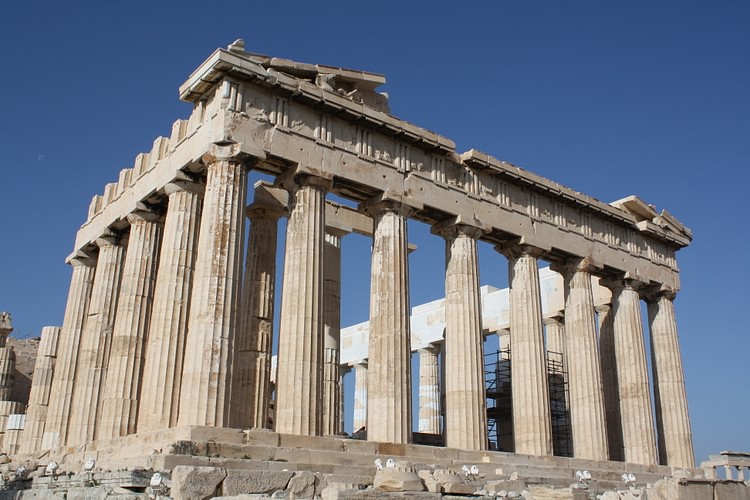
The city of Athens, Greece, with its famous Acropolis, has come to symbolize the whole of the country in the popular imagination, and not without cause. Athens began as a small, Mycenaen community and grew to become a city that, at its height, epitomized the best of Greek virtues and enjoyed such prestige that the Spartans refused to sack the city or enslave the citizens, even after Athens' defeat in the Peloponnesian War. This set a model that would be followed by future conquerors who would defeat Athens but not destroy it.
EARLY SETTLEMENT
Evidence of human habitation on the Acropolis and, below, in the area around the Agora, dates back clearly as far as 5000 BCE and, probably, as early as 7000 BCE. According to legend, the Athenian King Cecrops named the city after himself but the gods, seeing how beautiful it was, felt it deserved an immortal name. A contest was held among the gods on the Acropolis, with Cecrops and the citizenry looking on, to determine which deity would win the honor. Poseidon struck a rock with his trident and, as water gushed forth, he assured the people that now they would never suffer drought. Athena was next in line and dropped a seed into the earth which sprouted swiftly as an olive tree. The people thought the olive tree more valuable than the water (as, according to some versions of the story, the water was salty, as was Poseidon's realm) and Athena was chosen as patron and the city named for her.
UNDER PERICLES, ATHENS ENTERED HER GOLDEN AGE AND GREAT THINKERS, WRITERS, AND ARTISTS FLOURISHED IN THE CITY
As the soil was not conducive to large-scale agricultural programs, Athens turned to trade for its livelihood and, mainly, to sea trade. The early Mycenaean period (c. 1550 - 1100 BCE) saw massive fortresses rise all over Greece, and Athens was no exception. The remains of a Mycenaean palace can still be seen today on the Acropolis. Homer 's Iliad and Odyssey portray the Mycenaeans as great warriors and seafaring people, and there is no doubt they traded widely throughout the Aegean and Mediterranean region. In c. 1200 BCE the Sea Peoples invaded the Greek archipelago of the Aegean from the south while, simultaneously, the Dorians came down from the north into mainland Greece. While the Sea Peoples made definite incursions into Attica (the mainland region surrounding Athens) the Dorians by-passed the city, allowing the Mycenaean culture to survive (although, like the rest of Greece, there seems to have been an economic and cultural downturn following these invasions).The Athenians, afterward, claimed for themselves a special status in that they spoke Ionian, instead of Doric, Greek and held to customs they felt were superior to their neighbors.
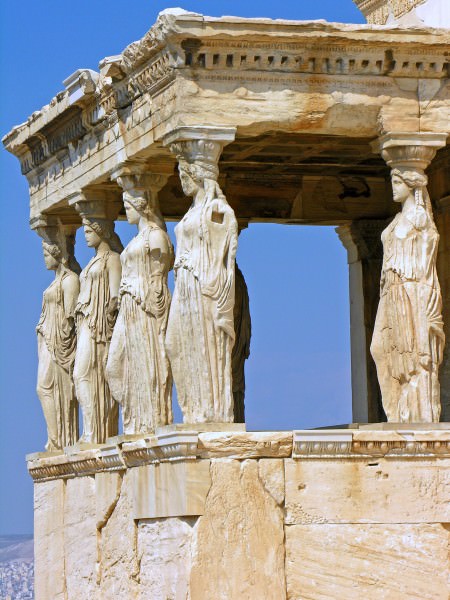
Caryatids of the Erechtheion
ATHENIAN GOVERNMENT & LAWS
The wealthy aristocrats held control of both the land and the government and, in time, poorer land owners became enslaved (or nearly so) through debt to the more wealthy. Further, there was a perceived lack of consistency among the other laws of the city. The first series of laws written to address these problems were provided by the statesman Draco (also known as Dracon/Drakon) in c. 621 BCE but were considered too severe (the penalty for most infractions was death), and so the great lawgiver Solon was called upon to modify and revise them. Solon, though an aristocrat himself, created a series of laws which equalized the political power of the citizenry and, in so doing, laid the groundwork for democracy in Athens in 594 BCE. After Solon resigned from public office various factional leaders sought to seize power and the ultimate victor, Peisistratos, recognized the value of Solon's revisions and kept them, in a modified form, throughout his reign as a benevolent tyrant. His son, Hippias, continued his policies until his younger brother, Hipparkhos, was assassinated over a love affair in 514 BCE.After this Hippias instituted a reign of terror which finally culminated in the overthrow of the Peisistratid tyranny in the Athenian Revolt of 510 BCE (backed by Sparta and lead by the Spartan Kleomenes). In the aftermath of the coup, and after settling affairs with Spartan factions such as Isagoras's bid for power, Cleisthenes was appointed to reform the government and the laws and, in 507 BCE, he instituted a new form of government which today is recognized as Democracy. According to the historian Waterfield, "The pride that followed from widespread involvement in public life gave Athenians the energy to develop their city both internally and in relation to their neighbors". This new form of government would provide the stability necessary to make Athens the cultural and intellectual center of the ancient world; a reputation which lasts even into the modern age.
After the Athenians (with the help of Plataeans) defeated the Persians at the Battle of Marathon in 490 BCE and, again, after driving off a second Persian invasion at Salamis in 480 BCE (and soundly defeating the Persians at Plataea and Mycale in 479 BCE), Athens emerged as the supreme naval power in Greece. They formed the Delian League, ostensibly to create a cohesive Greek network among city-states to ward off further Persian attacks, and, under the leadership of Pericles, grew so powerful that the Athenian Empire could effectively dictate the laws, customs, and trade of all her neighbors in Attica and the islands of the Aegean. The historian Waterfield writes:
There is no little irony in the fact that one of the things we most admire in the ancient Greeks is their love of freedom - and yet one of the chief manifestations of that love was their constant striving to control in some way the futures of their neighbors.
THE GOLDEN AGE
Even so, under Pericles, Athens entered her golden age and great thinkers, writers, and artists flourished in the city.Herodotus, the `father of history', lived and wrote in Athens. Socrates, the `father of philosophy ', taught in the marketplace. Hippocrates, `the father of medicine', practiced there. The sculptor Phidias created his great works for the Parthenon on the Acropolis and the Temple of Zeus at Olympia. Democritus envisioned an atomic universe. Aeschylus, Euripedes, Aristophanes, and Sophocles wrote their famous plays and Pindar his Odes. This legacy would continue as, later, Plato would found his Academy outside the walls of Athens in 385 BCE and, later, Aristotle 's Lyceum would be founded in the city centre.
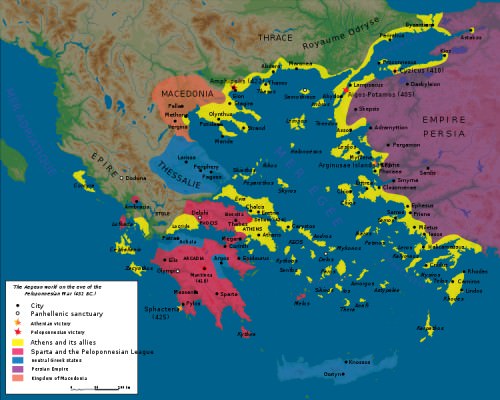
Peloponnesian War
The might of the Athenian Empire encouraged an arrogance in the policy makers of the day which grew intolerable to her neighbors. When Athens sent troops to help Sparta put down a Helot rebellion, the Spartans refused the gesture and sent the Athenian force back home in dishonor, thus provoking the war which had long been brewing. Later, when Athens sent their fleet to help defend its ally Cocyra ( Corfu ) against a Corinthian invasion during the Battle of Sybota in 433 BCE, their action was interpreted by Sparta as aggression instead of assistance, as Corinth was an ally of Sparta.
The Peloponnesian War (431-404 BCE) between Athens and Sparta (though involving, directly or indirectly, all of Greece) ended in disaster for Athens after her defeat. Her empire and her wealth gone, her walls destroyed, only her reputation as a great seat of learning and culture prevented the sack of the city and the enslavement of the populace. Athens struggled to throw off her condition as a subject state, and with some success, until they were defeated in 338 BCE by the Macedonian forces under Philip II at Chaeronea. Athens was then subject to Macedonian rule until their defeat by the Romans in 197 BCE at the Battle of Cynocephalae after which Greece was methodically conquered by the Roman Empire. It is a tribute to an enduring legacy that the Roman general Sulla, who sacked Athens in 87-86 BCE, slaughtered the citizenry, and burned the port of Piraeus, refused to allow his soldiers to burn the city itself. In the modern age the name of Athens still conjures to the mind words and images of the classical world and the heights of intellectual and poetic creativity, while the Parthenon on the Acropolis continues to symbolize the golden age of ancient Greece.
MAP
Ancient Greek Coinage › Antique Origins
Definition and Origins

The coinage of ancient Greece has given us some of the most recognisable images from antiquity as they were stamped with designs to proudly declare the identity of the city which minted them and guarantee their value. One of the great archaeological survivors, coins are an invaluable source of information on cultural practices, important individuals, and ancient international relations.
EVOLUTION & FUNCTION OF COINAGE
Trade in the ancient world was largely conducted through the exchange of one type of goods for another in a barter system that worked well for millennia. Eventually, some goods came to be exchanged for large metal bars, such as the bronze or copper talent, which both parties agreed to a value on. The next step was to use metal rods or spits (an obelos from which the obol coin derives its name) which were 1.5 meters in length and six of which could be grasped in the hand. The Greek word for grasp is drattomai and this is the origin of the drachma coin. From these bars and rods sprang the idea for a more portable and universal material which could be exchanged for any goods or service: coinage.
Lydia was credited by the Greeks with inventing coins in the early 6th century BCE which were stamped by the state to guarantee value and be recognisable as genuine. Coins were usually slightly lighter than the same value weight in the pure metal so that the cost of minting them was covered or even a small profit attained. In later centuries some states would abuse this margin and produce coins with lower and lower precious metal content in an attempt to create value where there really was none. After public ridicule, Athens was famously forced to withdraw a batch of plated coinage that had been minted following a financial crisis c. 406 BCE. Then, as now, coinage could only function if people had trust in its present and future value.
GREEK COINS OF PARTICULAR CITY-STATES CARRIED SPECIFIC DESIGNS WHICH WERE USED FOR CENTURIES, BECOMING INSTANTLY RECOGNISABLE SYMBOLS OF THAT CITY.
The first Greek coins appeared in Aegina c. 600 BCE (or even earlier) which were silver and used a turtle as a symbol of the city's prosperity based on maritime trade. Athens and Corinth soon followed Aegina's lead. The birth of coinage in wider Greece, though, was not really an invention of convenience but a necessity, driven by the need to pay mercenary soldiers.These warriors required a convenient way to carry their wages and the state needed a method of payment they could equally apply to everyone. For maritime trade especially, barter continued to be the most common form of exchange as the problem with coinage in the ancient world was that the value of coins between city-states was often different. Still, for the citizens of a particular city and its surrounding territories coinage became a very useful way to buy and sell goods, and it was convenient for the state to use coins to pay for small public services such as participating in law courts. So convenient was this new portable wealth that poorer Greeks would carry their coins in their mouths when they went to market, and richer Greeks now had a handy means of storing (and hiding) their wealth.
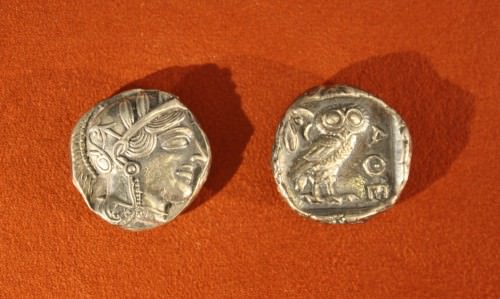
Athenian Silver Tetradrachm
Some larger states were able to impose their currency on other city-states and have it accepted as a means of exchange. The Athenian silver coinage of the 5th century BCE is an example, and perhaps it was the first case of a single currency being used by different states, the members of the Delian League. Examples of the Athenian silver owl tetradrachms have been found as far afield as Egypt, Palestine, Arabia, and Bactria. The Arcadian League was another organisation with a common coinage. Similarly, Alexander the Great would use his coins across the Macedonian empire with many states still minting them two centuries after his death. Other contemporary states would copy the Greek approach to coins and produce their own similar types, such as the Etruscans and Carthaginians.
MINTING COINS
Greek coins were made using mostly silver but also gold, electrum (a naturally occurring alloy of silver and gold), copper alloy, and bronze. The metals were melted in a forge hearth and then, to standardise the size and weight of each blank coin (flans), the molten metal was poured into moulds or pre-prepared hemispherical vessels. Later, another method was to cut slices from metal cylinders made the correct diameter.
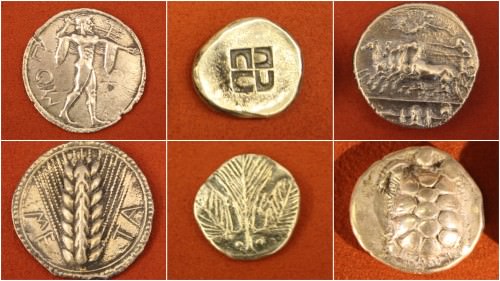
Greek Silver Coins
Meanwhile, an engraver carved the design (in relief or incised) onto metal dies of hardened bronze or iron, one for each side of the coin (early coins had only one side stamped). In some mints during the Classical period such as in southern Italy and Sicily, the coin engravers even signed their work. One die (usually the obverse side) was set in an anvil and the blank metal disk was placed on top, warmed to make it slightly soft. The minter then held in his hand the other die and hammered it on top of the blank disk. The strike would then leave an impression on both sides of the coin. Sometimes old coins were restamped with new designs.
Different weights of coins were used to create denominations ranging from the obol (six of which equalled one drachma) to the double octadrachm. What could be purchased with coins changed over time, but, as an example, entrance to the theatre festivals at Athens initially cost two obols in the early 5th century BCE, which was a day's labour. Most coins, though, were minted in silver and so were of relatively high value, perhaps equal to one week's work for most citizens. Only in the Hellenistic Period did smaller denominations become more widespread.
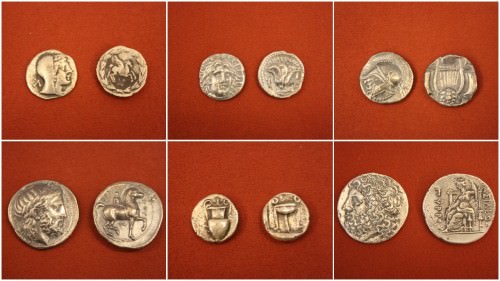
Ancient Greek Silver coins
There were attempts to manufacture counterfeit coins using a low-value core such as lead or bronze covered in a thin layer of the correct metal. As designs became more complex so they became more difficult to copy but early coins often have punch holes suggesting they were repeatedly tested to determine their true composition.
DESIGNS
Greek coins of particular poleis or city-states often carried specific designs which were used for centuries, becoming instantly recognisable symbols of that city. Gods and figures from Greek mythology were especially popular, but all manner of subjects were chosen to represent particular cities. Strangely, the reverse side of early coins usually had only a simple geometric shape stamped into them, especially a quartered square. Later, minters and administrators saw that the reverse side was an opportunity to double the visual message. Designs sometimes had a relation to the coin's value too, as when Athens added an extra olive branch to distinguish the similar hemidrachm and drachma.
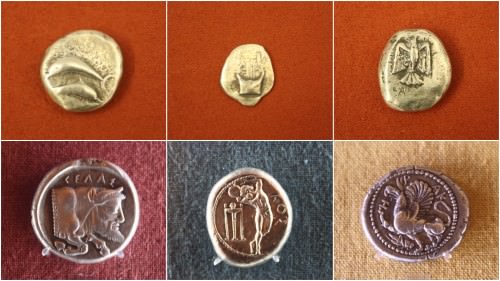
Ancient Greek Coins
Perhaps the most famous design of all is the owl of Athena which appeared on the silver tetradrachm coins of Athens. Athena was the patron of the city and she appeared on the reverse side. Corinth used Pegasus, the winged horse of the Corinthian hero Bellerophon who found him at the fountain of Pirene outside the city. Coins of Knossos depicted the labyrinth from the legend of Theseus and the Minotaur. Thebes had the distinctive Boiotian shield. Syracuse used the image of Arethousa with swimming dolphins to symbolise that city's strength through maritime trade. As we have seen, Aegina did the same but used a sea turtle, to be replaced by a tortoise on later coins. Poseidon appeared on the coins of Poseidonia, and Silenus on those from Naxos.
Local plants and flowers were a popular choice of symbol, too, for example, the celery leaf for Selinus, rose for Rhodes, and ear of wheat for Metapontum. Charioteers seem to have appealed to many city-states and appear on coins from Sicily to Macedon. The lyre is another common emblem, the coins of Delos being just one example. Some coins had short inscriptions, most commonly a single letter such as an Athe for Athens or Koppa for Corinth. By the end of the Classical period, rulers were using coins as a means of propaganda to show their own image throughout their empire and associate themselves with gods and heroes such as Hercules.
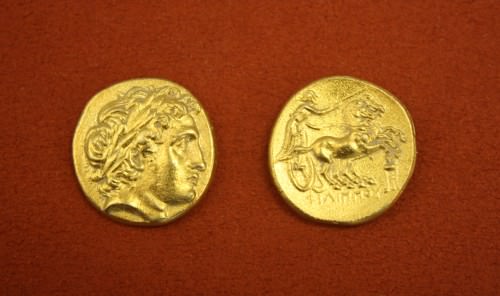
Macedonian Gold Stater
A VALUABLE HISTORICAL RECORD
The imprecise process of manufacturing coins in the Greek world has been a valuable asset to archaeologists. By examining the precise metal purity of certain coins and the alignments of designs and their imperfections they are able to match different examples of the same coin batch to specific mints and periods, helping to date other objects and places in which the coins have been excavated. On occasion, the mere presence of coins in certain places has helped establish ancient trade relations, for example. Finally, the images on coins are a valuable source of iconography related to the Greek religion and a record of agriculture and architecture. They are, too, a visual reference for all kinds of now lost objects from victory tripods to ships' prows, and sometimes, as with many Bactrian kings, they are our only source of an individual's portrait.
LICENSE:
Article based on information obtained from these sources:with permission from the Website Ancient History Encyclopedia
Content is available under License Creative Commons: Attribution-NonCommercial-ShareAlike 3.0 Unported. CC-BY-NC-SA License